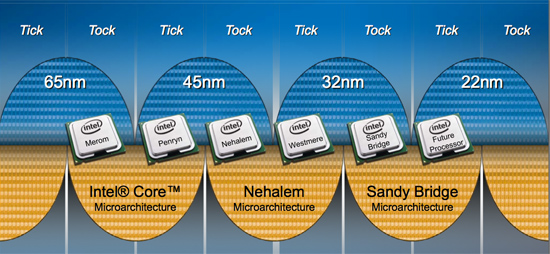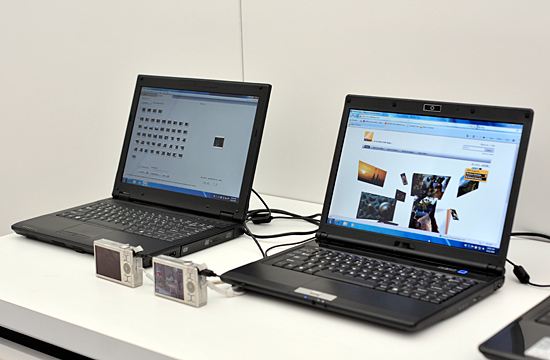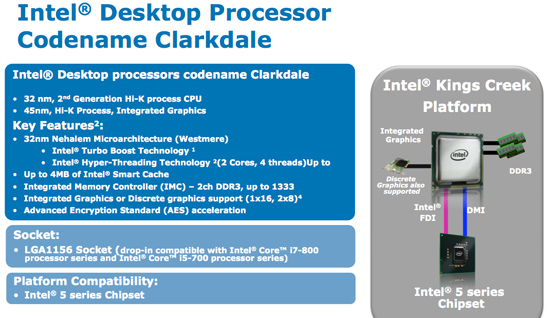The Real Conroe Successor: Clarkdale & All You Need to Know about Westmere
by Anand Lal Shimpi on September 24, 2009 6:00 PM EST- Posted in
- CPUs
Intel spent a lot of time talking about Nehalem a year ago, but not much time on Westmere. It's the tick to Nehalem's tock, or in other words, it's 32nm Nehalem.

Unlike previous die shrinks, we don't get larger caches with Westmere - Nehalem was already too big to begin with. Westmere keeps the same architecture, same cache sizes (or ratios) as Nehalem. It's all built using smaller 32nm transistors and on a smaller die. For the same core count, expect Westmere to be roughly half the size.
But the same core counts aren't what you're going to get. I included the table below in yesterday's Core i7 920XM preview:
| Codename | Market | Cores | Manufacturing Process |
| Bloomfield | Desktop | 4 | 45nm |
| Lynnfield | Desktop | 4 | 45nm |
| Clarkdale | Desktop | 2 | 32nm |
| Clarksfield | Mobile | 4 | 45nm |
| Arrandale | Mobile | 2 | 32nm |
The Westmere products are Gulftown, Clarkdale and Arrandale. That's six, two and two cores. Lynnfield is the last quad-core on the roadmap for the foreseeable future.

We'll talk about Gulftown later, but the focus today is Clarkdale with a little Arrandale.
Meet the 'dales
Arrandale and Clarkdale are the first two Westmere family members you'll meet. Both are technically due out later this year, although we won't see large volumes (by Intel standards) until Q1 2010. Both Arrandale and Clarkdale are dual-core Westmere parts with on-package graphics. The only difference is that Arrandale is mobile while Clarkdale is desktop.

Arrandale running - Hyper Threading helps improve performance even in normal workloads

The desktop socket is LGA-1156, the same socket as Lynnfield. The mobile socket is mPGA-989, the same socket as Clarksfield.










96 Comments
View All Comments
Arbie - Friday, September 25, 2009 - link
Is this true? Right when apps will begin to really use the quads, Intel is going to stop making new ones?That's amazing, but good news because it will give AMD a great opportunity to recover. They can sell a quad against any Intel dual as long as the base clocks have the same first digit. Nobody (statistically) is going figure that even a double-throwdown super-trick over-and-under hyperthreaded handshaking pair will beat four of a kind, across the board. It might be true, but it won't sell at Best Buy.
Arbie
Arbie - Friday, September 25, 2009 - link
Oh - now I see. No new quads until Sandy Bridge. Well, that will at least give AMD some time to make hay. They need it, and we need them.grimpr - Friday, September 25, 2009 - link
Unfortunately, Clarkdale is NOT the Conroe succesor, despite all the stiring of enthusiasm and feelings about Conroe that our dear Anand likes to provoke. As TAH152 points out, its a half baked product like Lynnfield, everyone thats taking a serious look at the platforms and products of 2011 will clearly see the complete and mature solutions that will arise in that year, cpu and platform wise, Sandy Bridge, the TRUE Conroe successor from Intel and a completely new architecture from AMD.Dont bite for just a piece of blue sky.
gwolfman - Friday, September 25, 2009 - link
Ooooo, I want! I'll replace my Intel G45FC without even having to think about it! :)gwolfman - Friday, September 25, 2009 - link
@AnandAny news on those 4 SATA + eSATA ports supporting RAID5? I hope so!
vshin - Friday, September 25, 2009 - link
The final piece of the puzzle has been revealed and now we can map out the right path to upgrade for the budget enthusiast PC gamer market (<$250 CPU budget, no SLI).Clarkdale is not the answer. This is a CPU for the casual non-gaming PC user and the HTPC market. On board graphics and 2 cores do not make this the ideal upgrade choice for the majority of us.
Bloomfield was the answer. It's still a great CPU on a great chipset but it will cost more than a Lynnfield without a proportional payoff in gaming performance. Yes the X58 platform might be "future-proof" since Gulftown will be a drop-in upgrade. But Gulftown is rumored to start at $1000. This makes X58 a dead-end money-pit. Even if Gulftowns eventually drop in price, by that time Sandy Bridge will be out, along with USB 3.0, PCIe 3.0, and SATA III so you'll want to upgrade your motherboard anyways.
Lynnfield may be a "crippled" Bloomfield but this is the least expensive option for us until Sandy Bridge. There might be a 32nm version but probably not until mid 2010. In any case, all we need is to build a system that will perform well until around 2011-12 since we'll want to upgrade our motherboards by then anyways. So go with a low budget system for now, perhaps a Lynnfield 750 (or 860 if you can find one for under $250), a non-SLI 1156 mobo (under $120), with 4GB DDR3 1600 ram (<$90). Throw in a decent heatsink and overclock this sucker as high as you can.
I just want to make clear that I don't hate the Bloomfield. It's still better than Lynnfield but less bang-for-your-buck to the typical budget gamer. I suppose if you can spare the cash (>$250 for CPU) or plan on building an SLI setup, you wouldn't be wrong to go with a Core i7 920, especially if you can pick up a D0 stepping at the local Microcenter for $200. ASRock has a socket-1366 motherboard selling for $170 with SLI/Crossfire, which is probably the best deal you're going to get for this platform. I think decent 6GB DDR3 1600 triple-channel kits can be found for around $120.
TLDR version:
If you want to spend <$250 on a CPU, then go with Lynnfield.
If you can spend >$250 on CPU and want to SLI, fold proteins, or encode video, then go with Bloomfield.
bobbrb - Friday, September 25, 2009 - link
Is there any info available on sockets/chipsets spec for future 22nm processors? I've been waiting to build a monster rig for few months now and keep postponing with news of better chips coming out... but I set the deadline for Jan'10 and it looks like Clarkdale will be the winner for me. But... it looks like it will come out with only 2 cores (what's up with that???). So I'll be looking for good mobo with plenty room to grow and 2-core Clarkdale hoping to upgrade the chip once 22nm processors come out - that's if sockets/chipset support will allow.chizow - Friday, September 25, 2009 - link
Just seems like its going to be really short-lived. It'll capture the low-end, maybe $150 and lower because above that you have Lynnfield. On the high-end, 6-core and $1000 for Gulftown puts it out of reach for even most X58 users, and no 4-core Westmere part means no upgrade path for current Bloomfield owners.Then you have Sandy Bridge in late 2010....meaning Westmere will have a shelf-life of about a year? Or will 32nm Westmere low-end parts not see a refresh until Ivy Bridge? Almost seems like Intel is going away from its straight refresh approach and alternating high and low-end parts on their Tick and Tock and coordinating with the process shrinks.
Better for the consumer I suppose, as it offers 2 year life cycles for their preferred performance bracket, but seemingly worst for Intel's bottom-line. Unless they think their bottom-line is best served pacing their progress due to lack of any real competition from AMD.
strikeback03 - Friday, September 25, 2009 - link
Enthusiast irrelevance maybe, but it will probably be huge in laptops (which will probably make up over 50% of processor sales for most if not all of the life of these chips) and will also fill in the cheaper desktops from HP, Dell, etc. So yes, the Westmeres seem to be skipping the midrange market, but I imagine they will still sell plenty of them.Too bad, I'd love a 32nm 4 core/8 thread part for under $300, but they took so long releasing Lynnfield after Bloomfield that obviously they are not anxious to turn right around and replace the 45nm i7s with 32nm.
chizow - Friday, September 25, 2009 - link
Yep but again, that all hinges on whether or not there's a 32nm Sandy Bridge refresh of this low-end, or not. I'm guessing not. 11-month life span would be short even by Intel's standard. I guess their new plan will be to space out generations further, especially as they venture into greater core plurality. Last I heard 8-core was going to be the baseline core # for Sandy Bridge.